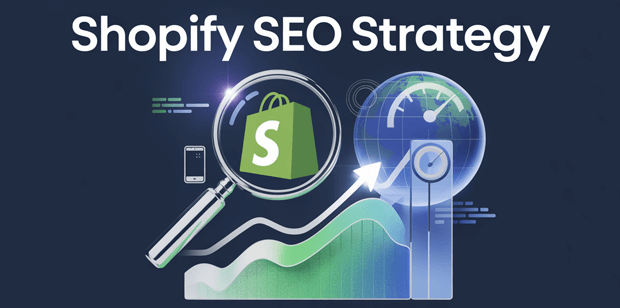In 2025, Shopify SEO strategy remains the backbone of sustainable eCommerce growth.
Over 70% of online shoppers ignore paid ads, focusing solely on organic results , yet only 30% of Shopify stores fully leverage SEO to capture this audience.
With 2.1 million active Shopify stores competing globally, a robust SEO plan isn’t optionalit’s survival.
A well-executed Shopify SEO strategy can increase organic traffic by 300% within six months , while poor optimization leaves your store invisible.
This guide walks you through actionable steps to dominate search engine results pages (SERPs), backed by data, tools, and proven tactics.
Keytakeway
- Shopify’s Built-in SEO Features: Leverage Shopify’s automatic sitemaps, meta-tag customization, and mobile-friendly themes to build a strong foundation for your SEO strategy.
- Technical SEO Mastery: Optimize site speed, canonical tags, and mobile responsiveness to boost rankings by up to 30% and enhance user experience.
- Content-Driven Authority: Create keyword-rich product descriptions, blog posts, and user-generated content (UGC) to drive engagement and conversions.
- Avoid Common Pitfalls: Fix duplicate content, slow page loads, and thin content using tools like Plug in SEO and SEO Manager to maintain competitiveness.
- Advanced Tools & Metrics: Utilize apps like Smart SEO and Google Analytics 4 to track KPIs like organic traffic growth (10–20% monthly) and conversion rates (avg. 1.4% for Shopify).

1. Technical SEO: The Foundation of Your Shopify Store
Technical SEO ensures search engines can crawl and index your store efficiently. Here’s how to get started:
Optimize Site Speed
Google considers page load time a top-ranking factor. A 1-second delay in mobile load time increases bounce rates by 32% . Use Shopify’s free speed report tool to audit performance, and compress images with tools like TinyPNG (avg. compression: 45% .)
Leverage Automatic Sitemaps
Shopify generates XML sitemaps automatically (e.g., ‘yourstore.com/sitemap.xml’), but verify they’re submitted to Google Search Console. Update sitemaps weekly to index new products and collections .
Fix Canonical Tags
Duplicate content (e.g., similar product descriptions) harms SEO. Shopify’s canonical tags tell search engines which version to prioritize. Ensure every page has a unique `<link rel=”canonical”>` tag .
Prioritize Mobile Optimization
Over 53% of organic traffic comes from mobile devices . Test mobile usability with Google’s Mobile-Friendly Test, and use responsive themes like Dawn (Shopify’s fastest theme .
Core Web Vitals: Speed and Stability
Google’s Core Web Vitals (Largest Contentful Paint, Cumulative Layout Shift, and Interaction to Next Paint) directly impact rankings. Shopify stores load 1.8x faster than average platforms , but further optimize by:
- Compressing images to 100KB or less.
- Minifying CSS/JS code.
- Using lazy loading for non-critical assets.
SSL Certificates and Secure Checkout
Secure websites (HTTPS) rank higher and build trust. Shopify automatically provides SSL certificates, but audit checkout pages to ensure secure transactions and reduce cart abandonment .
2. On-Page SEO: Targeting High-Value Keywords
On-page SEO aligns your content with what your audience searches for.
Keyword Research: Match Search Intent
Start with tools like Semrush or Ahrefs to find keywords with high volume and low competition. Focus on long-tail keywords like “eco-friendly yoga mats for beginners” (avg. 30% higher conversion rates .
Pro Tip: Use Google’s “People Also Ask” section to uncover question-based keywords (e.g., “How to choose a vegan skincare routine?”).
Optimize Product Pages
Each product page should include:
Title tags: Keep under 60 characters; include primary keyword (e.g., “Organic Skincare Kit | Vegan Face Cream Set”) .
Meta descriptions: Add a call-to-action (CTA) and keyword (e.g., “Shop cruelty-free skincare essentials. Free shipping!”).
Alt text: Describe images using concise phrases (e.g., “Vegan face cream with chamomile extract”).
Create SEO-Optimized Collections
Organize products into themed collections (e.g., “Summer Sale Dresses”) and write unique descriptions with keywords. Use filters to help users narrow searchesa key ranking factor for Shopify .
Structured Data and Rich Snippets
Implement schema markup (JSON-LD) to highlight prices, reviews, and availability in rich snippets.Use an app like GP JSON‑LD Schema for SEO automate this process, boosting click-through rates by 20%+ .
Internal Linking for Authority
Link related products and blog posts to improve crawlability. For example, a “Summer Dresses” collection could link to a blog post titled “Top 10 Summer Outfits.”
3. Content Marketing: Building Authority and Trust
Content drives 67% more conversions than traditional marketing . Focus on:
Blogging for SEO
Publish 2–3 blog posts monthly targeting keywords relevent to your businsess. Topics to explore:
- Case studies.
- How-to guides
- Industry trends
Use internal links to connect blogs to product pages, improving dwell time and rankings .
User-Generated Content (UGC)
Encourage customers to leave reviews and share photos. Stores with UGC see 90% higher conversion rates.
Embed hashtags like ‘MyEcoSkincare’ to build community and backlinks.
Apps like Rivyo: Reviews & Loyalty make it easy to generate UGC by automating review collection, showcasing star ratings, and displaying photo reviews, helping you turn satisfied customers into your strongest marketing asset.
Video Content
Video product descriptions increase time on page by 50% . Upload shorts to YouTube of your products and link to your store.
Long-Form Content and Guides
Create in-depth guides (2,500–3,000 words) to rank for competitive keywords.
For example, “The Ultimate Guide to buying a Smartphone” can attract 10x more backlinks than short posts .
4. Common Shopify SEO Mistakes to Avoid
Avoid these pitfalls to stay ahead of competitors:
Thin content: Product pages with <300 words struggle to rank. Add detailed descriptions and FAQs .
Ignoring structured data: Use schema markup to highlight prices and reviews in rich snippets .
Slow checkout: A 10-second checkout load time increases cart abandonment by 87% .
Duplicate Content Issues
Shopify’s collection feature often creates duplicate URLs (e.g., `/collections/category/product-name` vs. `/products/product_name`). Fix with canonical tags or 301 redirects .
URL Structure Optimization
Use clean, keyword-rich URLs like `examplestore.com/boots/black-timberland-boots/` instead of `examplestore.com/boots/82371` .
Missing Alt Text and Meta Descriptions
Ensure every image has descriptive alt text (e.g., “Black Timberland Boots for Men”) and meta descriptions include CTAs like “Shop Now” .
5. Measuring Success: Key Metrics to Track
Monitor these KPIs to refine your Shopify SEO strategy:
- Organic traffic: Aim for 10–20% monthly growth.
- Keyword rankings: Track top 10 positions for 10–20 priority keywords.
- Conversion rate: Benchmark against industry averages (avg. 1.4% for Shopify .
- Use Google Analytics 4 to identify high-performing pages and A/B test CTAs.
Google Search Console (GSC)
Submit sitemaps and monitor Core Web Vitals. Fix crawl errors and speed issues to improve indexing .
Backlink Analysis
Tools like Semrush track referring domains and anchor text diversity. Aim for 500+ referring domains within 6 months .
Heatmaps and User Behavior
Use Hotjar to analyze click patterns and exit rates. For example, optimizing a high-exit product page boosted conversions by 35% for UrbanBeardman .
Frequently Asked Questions
How long does Shopify SEO take to show results?
Most stores see improvements in 3-6 months, depending on competition and content quality.
Are backlinks still important for Shopify SEO?
Yes! Backlinks from authoritative sites (e.g., Forbes, HuffPost) boost domain rating. Guest post on niche blogs to earn links.
Can Shopify apps replace manual SEO?
Apps automate tasks but can’t replace strategic planning. Use them alongside human expertise.
How often should I update my Shopify SEO strategy?
Review analytics monthly and refresh content quarterly to align with algorithm updates.
What is the best Shopify theme for SEO?
Themes like Dawn and Mavon are lightweight and mobile-optimized, improving LCP scores by 25%.
Conclusion: Outrank Competitors with a Future-Proof Strategy
A winning Shopify SEO strategy combines technical precision, keyword-driven content, and continuous optimization.
By prioritizing user experience, leveraging Shopify’s tools, and staying ahead of trends (like AI-powered content creation), you’ll dominate SERPs and build lasting authority.
Remember: SEO isn’t a one-time task. It’s a marathon. Start today, track progress, and adapt relentlessly.



